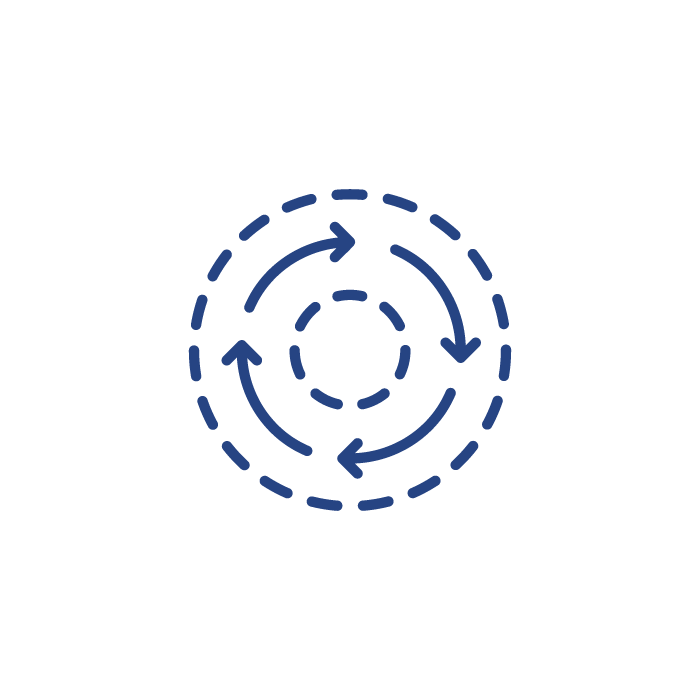Agile Transformation for Federal Agency
The Challenge
Many Federal agencies are adopting Agile software development. Agile adoption is often a disruptive process for many agencies where waterfall software development is a deeply entrenched culture from procurement to deployment.
Agile Framework
Agile software development is a framework for delivering working software frequently and efficiently. The Agile process has been widely accepted as best practice in the industrial sector and it is time that Federal agencies adopt Agile to modernize their large and complex computer systems to deliver value efficiently.
Makpar’s Approach
Makpar has a pragmatic approach to Agile transformation. We transform clients to an Agile practice to mitigate risk and increase value through frequent deliveries which add consistent value to the client’s mission. We have a working history with a long-time Federal Agency client where we introduced Agile to modernize some of the agency’s systems.
The 5 Pillars of our Agile Center of Excellence
-
LPM aligns mission strategy to execution. This facilitates management decisions and roadmaps and focuses on high value activities with early risk mitigation. Top decisions are still made by top management, while
Makpar uses Agile in the middle for program management, which assists in metric transparency. Federal Agencies can still maintain hierarchical governance while maintaining personnel to manage the portfolio in an Agile way.
LPM addresses governance issues and facilitates cumbersome decision making in a risk averse culture. It aligns Agile development with business strategy by delivering value to customers through products and solutions.
-
Dynamic Reporting and Dashboarding helps provide accurate information for enabling executive decision making.
Reports are data-generated and available real-time on the Program Dashboard, so everyone sees and understands the programs dynamics daily. This reduces risk by improving internal collaboration.
Dynamic reporting also supports formal reporting and distribution. Makpar’s online reporting tool keeps stakeholders, management and teams informed and up to date on Program metrics.
-
Value-Based Empowerment is Makpar’s Agile approach for value delivery. We encourage teams to be autonomous at the delivery level and let them decide and assess the amount of work they can handle.
Teams take decisions on what needs to be done to meet the requirements; they can also decide the timeline for delivery. Teams align according to functionality, release, and organizational goals. They use metrics for accountability and visibility.
Our approach enables a culture of asking questions which facilitates efficiency and mitigates risks. Our Value-Based Empowerment approach boosts the confidence of the agency’s front-line personnel by authorizing them to take decisions at the team level while balancing respect for the chain of command.
-
Makpar uses the Pivot on Demand approach to recalibrate and adjust to emerging requirements and client goals. Teams ensure that new technologies are not wasted by repurposing and adapting them to satisfy client needs.
-
Our Metrics-Based Decision-Making approach helps measure the momentum and progress of our program. These metrics are translated to Key Performance Indicators (KPIs) and success indicators for management to evaluate the programs progress.
Solution & Benefits to Client
Our Agile approach ensures the use of quality reviews and program control reviews to assess and monitor program efficiency. We consistently monitor all processes to ensure that they meet the required standards, guidelines, and metrics.
This enables us to identify trends, weaknesses and gaps in procedures and helps us improve the quality of the product/solutions we deliver. We perform quality control and quality assurance reviews for each stage of the program to identify and mitigate risks.
-

Increased Efficiency
Our pragmatic approach to Agile practice ensures efficiency through the collaboration of smaller groups to create a more trusting and friendly working environment.
-

Consistent Cadence
Our approach reduces the overall duration of delivery by introducing the Agile concept of cadence, which defines the team’s development lifecycle. Consistent cadence makes milestones predictable and achievable. More collaboration on the team level results in faster completion of development and testing, faster completion of development and automated testing means zero defects make it into the final code.
-

Adaptability
We adapt quickly to changing conditions and client requirements. Teams can pivot to adapt to changing priorities without affecting release timelines. Frequent inspect & adapt events, such as Retrospective and Data/Digital Service Units (DSUs) allow transparency and facilitate course corrections in sprints.
-

Buy-In
Our approach keeps the product owners and business customers involved and engaged, and helps obtain management and leadership buy in.

